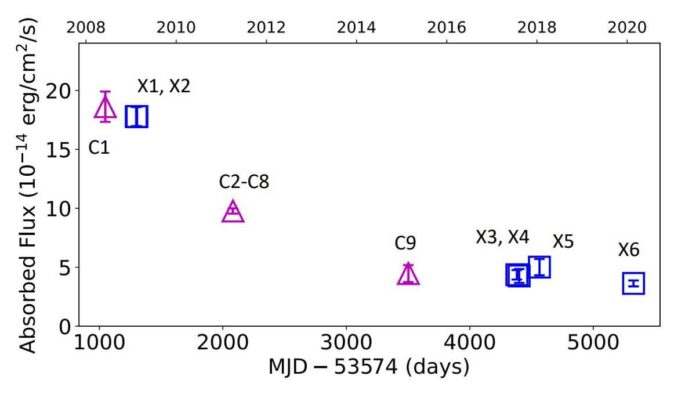Astronomers from Radboud University in the Netherlands have conducted X-ray observations of a tidal disruption event. The event is known as 3XMM J150052.0+015452 or J150052 for short. The scientists have used NASA’s Chandra and ESA’s XMM-Newton space telescopes. J150052 was triggered by a rapidly spinning intermediate-mass black hole. The discovery was detailed in a paper published on arXiv.org.
When a star comes close enough to a supermassive black hole it is pulled apart by the black hole’s tidal forces. The result of this is a phenomenon known as a tidal disruption event (TDE). The tidally disrupted stellar debris starts raining down on the black hole. Then the radiation emerges from the innermost region of accreting debris and it is an indicator of the presence of a TDE.
TDEs are potentially significant probes of strong gravity and accretion physics for astronomers. This is offering insights into the genesis and evolution of supermassive black holes.
J150052 was first detected in 2005 as an X-ray source. Its position was coincident with the center of the galaxy SDSS J150052.07+015453.8 at a redshift of 0.145.
Follow-up observations of this source have found that it is a slowly-decaying TDE. It was experiencing a decade-long decay. Studies have also suggested that the black hole responsible for J150052 has a mass of around 100,000 solar masses. This makes it an intermediate-mass black hole (IMBH).
A team of astronomers led by Radboud’s Zheng Cao confirmed the IMBH hypothesis.
The black hole mass for J150052 was measured to be about 200,000 solar masses. The dimensionless spin parameter of the black hole was calculated to be at least 0.97. The researchers concluded that J150052 is a fast-spinning IMBH.
The mass and spin measurements indicate that J150052 did not form near its current mass. Scientists are assuming that the black hole must have accreted up to its current mass in episodes. There the angular momentum vectors of the spin and accreted material were aligned.
J150052’s spectral analysis indicates that it goes through a transition during its decay. It was quenching the corona as the mass accretion rate drops from super-Eddington to Eddington levels. The corona of J150052 was also discovered to be optically thick and warm by the scientists.
The researchers concluded that their findings demonstrate the potential of using the X-ray spectra of TDEs to find IMBHs and measure their masses and spins.
More information: Z. Cao et al, The Rapidly Spinning Intermediate-Mass Black Hole 3XMM J150052.0+015452, arXiv (2022). DOI: 10.48550/arxiv.2211.16936

